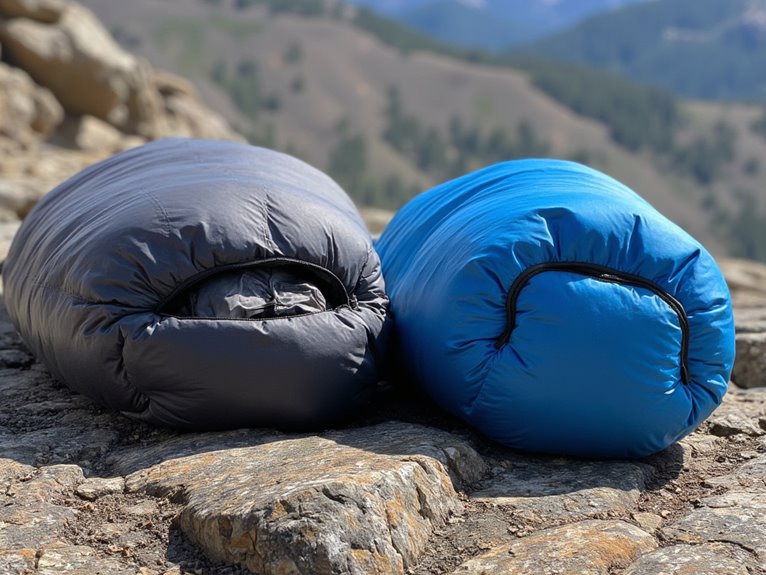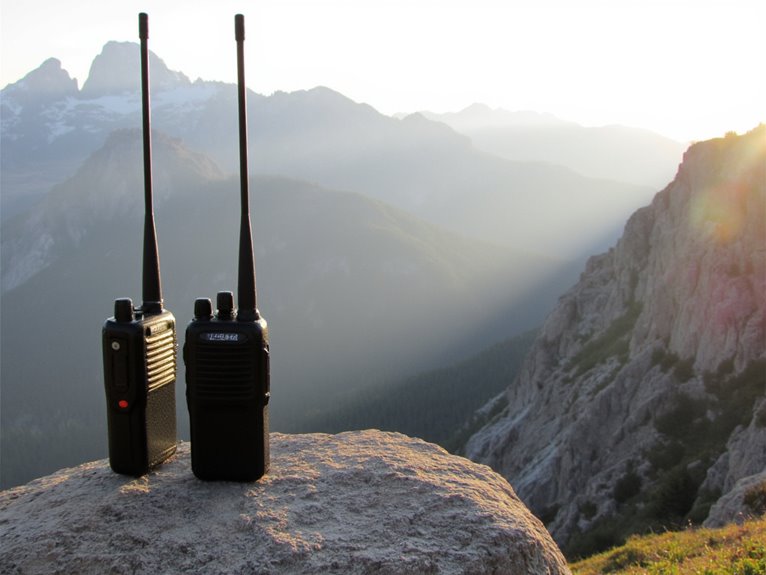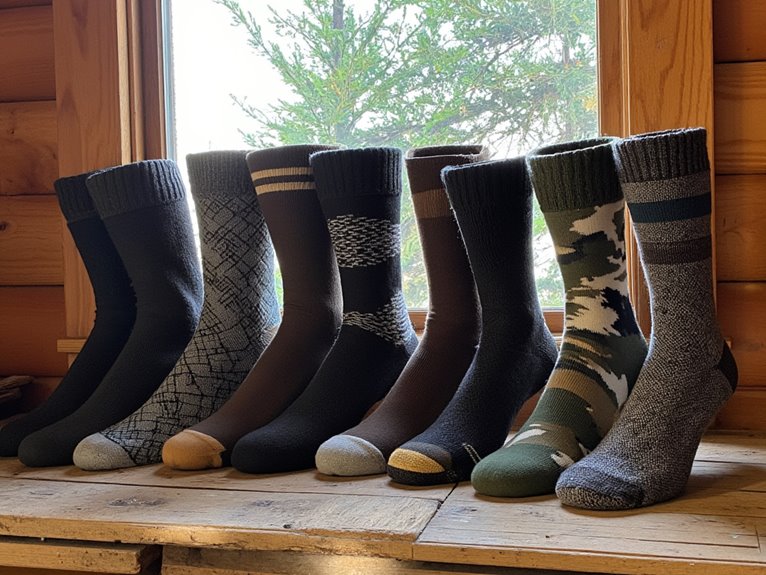Best Rectangular Sleeping Bags for Backpacking in 2025
I’ve tested dozens of rectangular sleeping bags for backpacking, and the top performers balance spacious comfort with reasonable pack weight. The KingCamp offers excellent value at 4.6 pounds with waterproof construction and 53.6°F comfort rating, while the Naturehike weighs just 1.8 pounds for ultralight adventures. For cold weather, the TETON Celsius XL handles -25°F conditions but weighs 9.5 pounds. The Coleman options provide reliable mid-range performance between 20°F and 40°F temperature ratings. Continue below for detailed specifications and my complete testing results.
We are supported by our audience. When you purchase through links on our site, we may earn an affiliate commission, at no extra cost for you. Learn more. Last update on 4th December 2025 / Images from Amazon Product Advertising API.
Notable Insights
- KingCamp Sleeping Bag offers 86.6 x 39.4 inch dimensions with waterproof exterior and converts to blanket at 4.6 pounds.
- TETON Celsius XL provides extreme cold weather protection down to -25°F with 90L x 36W inch dimensions for spacious comfort.
- Weight ranges vary significantly from ultralight 1.58 pounds to heavy-duty 9.5 pounds, affecting backpacking portability and comfort trade-offs.
- Temperature ratings span from warm weather (36-45°F) to extreme cold (-25°F), with most rectangular bags suitable for car camping.
- Key features include compression sacks, anti-snag zippers, draft tubes, and water-resistant materials for durability and thermal efficiency in backcountry conditions.
KingCamp Sleeping Bag for Adults, Cold Weather & Waterproof
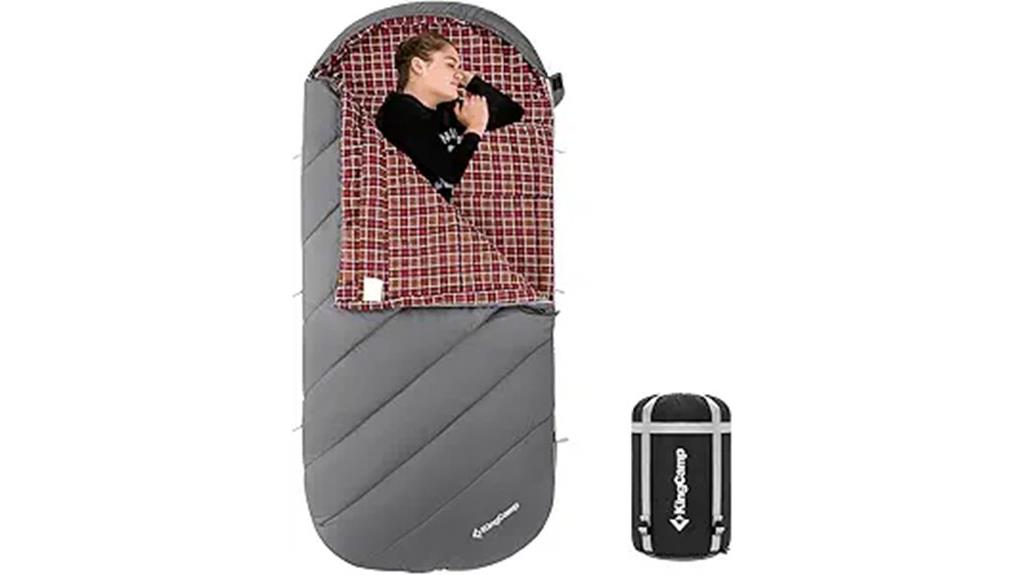
The KingCamp Sleeping Bag delivers exceptional versatility for backpackers who prioritize comfort without sacrificing functionality. You’ll appreciate its 86.6 x 39.4-inch dimensions that provide unrestricted movement during sleep. The 86% cotton and 14% polyester construction offers durability while maintaining breathability.
This bag handles three-season camping effectively with its 250g hollow fiber filling. You’ll stay comfortable down to 53.6°F, with limit temperatures reaching 42.8°F. The 100% waterproof polyester 210T exterior protects against moisture while ultra-soft cotton flannel lining guarantees comfort.
At 4.6 pounds, it packs into a 15 x 9.4-inch compression bag for easy transport. The full-length zipper converts it into a blanket for versatile use.
Best For: Three-season campers and backpackers who need a spacious, waterproof sleeping bag that can double as a blanket for couples or versatile outdoor use.
Pros:
- Converts to a full blanket with complete zipper opening, making it versatile for couples or as a camping quilt
- Waterproof exterior with breathable fabric protects against moisture while preventing condensation buildup
- Generous dimensions (86.6 x 39.4 inches) provide ample room for movement without feeling restrictive
Cons:
- At 4.6 pounds, it’s heavier than ultralight alternatives preferred by serious backpackers
- Comfort temperature of 53.6°F limits use in truly cold weather conditions
- Cotton-heavy construction may retain moisture and take longer to dry compared to synthetic alternatives
Warm Weather Sleeping Bag for Camping (36℉ to 45℉) with Compression Sack

Spring and summer backpackers seeking versatile warmth will find this rectangular sleeping bag delivers reliable performance in mild conditions. The 36℉ to 45℉ temperature range suits three-season camping perfectly. You’ll appreciate the spacious 87″ x 35″ dimensions that accommodate taller users comfortably.
The construction features water-resistant 40D polyester shell with tear-resistant properties. Interior materials include 1.4D ultra-fine fibers and 7D hollow fibers for ideal insulation. The brushed lining provides softness against your skin during extended use.
Practical features enhance field performance notably. You’ll access the internal smartphone pocket measuring 19×15 cm for device protection. The L-shaped double zipper converts the bag into a blanket when fully opened. At 1.58 kg with compression sack included, portability remains excellent for backpacking applications.
Best For: Spring and summer backpackers who need a versatile, lightweight sleeping bag for mild weather camping in temperatures between 36℉ to 45℉.
Pros:
- Spacious 87″ x 35″ design accommodates taller users and converts to a blanket with L-shaped double zipper
- Lightweight at 1.58 kg with compression sack for easy portability during backpacking trips
- Water-resistant 40D polyester shell with tear-resistant properties and practical smartphone pocket
Cons:
- Limited temperature range (36℉ to 45℉) restricts use to warmer weather conditions only
- Customer reviews indicate concerns about insulation quality for colder temperatures
- Mixed effectiveness in winter conditions with adequate warmth retention only at higher temperatures
TETON Celsius XL Sleeping Bag (-25F to 20F) with Compression Sack

Cold-weather adventurers who prioritize warmth and comfort over pack weight will find the TETON Celsius XL an exceptional choice for winter camping excursions. This rectangular sleeping bag delivers reliable performance in extreme conditions with temperature ratings spanning -25°F to 20°F. You’ll get 90L x 36W inches of sleeping space in a design that weighs 9.5 pounds.
The bag features 70D polyester ripstop construction with poly-flannel lining and innovative fiber fill insulation. Double-layer construction and draft tubes enhance thermal efficiency. However, the substantial weight makes this better suited for car camping than serious backpacking adventures where every ounce matters for trail performance.
Best For: Cold-weather campers and car camping enthusiasts who prioritize warmth and comfort in extreme conditions over pack weight and portability.
Pros:
- Exceptional warmth with temperature ratings from -25°F to 20°F, featuring innovative fiber fill and double-layer construction
- Spacious rectangular design (90L x 36W inches) with poly-flannel lining provides ample room and comfort for various sleeping positions
- High-quality construction with 70D polyester ripstop material, smooth zippers, and limited lifetime warranty backed by 4.5-star rating from over 3,000 customers
Cons:
- Heavy at 9.5 pounds, making it unsuitable for backpacking or long hiking trips where weight matters
- Can cause overheating and humidity buildup in warmer conditions above freezing temperatures
- Bulky even with compression sack, limiting portability and storage options compared to ultralight alternatives
Coleman Dunnock Cold Weather Sleeping Bag 20°F for Adults

Backpackers seeking reliable warmth in frigid conditions will find the Coleman Dunnock Cold Weather Sleeping Bag delivers consistent 20°F temperature protection through its Fiberlock construction system. This rectangular design accommodates adults up to 6’4″ while weighing 9.2 pounds—reasonable for cold-weather backpacking applications.
The Thermolock draft tube prevents heat loss through the zipper, while the patented 2-way ZipPlow system eliminates fabric snagging during operation. You’ll appreciate the base unzip feature for ventilation control when temperatures rise. The cotton flannel liner provides comfort against skin, though synthetic alternatives offer better moisture management.
At 19.69L x 11.42W x 3 inches packed, it’s compact enough for extended trips where warmth takes priority over ultralight weight considerations.
Best For: Backpackers and campers who prioritize reliable warmth and comfort in cold weather conditions down to 20°F and don’t mind carrying a slightly heavier sleeping bag.
Pros:
- Fiberlock construction and Thermolock draft tube provide reliable warmth retention and minimize cold spots
- Spacious rectangular design accommodates adults up to 6’4″ with comfortable cotton flannel liner
- Practical features like 2-way ZipPlow system, base ventilation, and machine-washable design enhance usability
Cons:
- At 9.2 pounds, it’s heavier than ultralight alternatives for weight-conscious backpackers
- Cotton flannel liner offers poor moisture management compared to synthetic materials
- Customer reviews indicate issues with external material durability and storage case design
Coleman Sun Ridge 40°F Cool-Weather Sleeping Bag
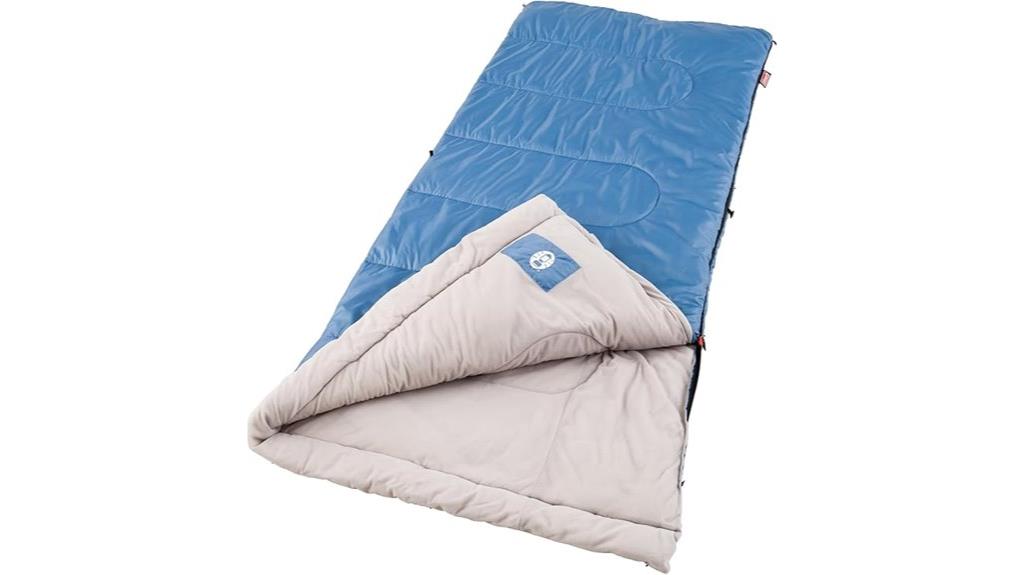
The Coleman Sun Ridge represents an ideal entry point for casual backpackers who prioritize comfort over ultralight specifications. This 40°F-rated bag delivers reliable warmth through its Fiberlock construction, which maintains insulation placement during use and storage. The Thermolock draft tube effectively prevents heat loss along the zipper line.
You’ll appreciate the soft ComfortCuff fabric trim that surrounds your face for enhanced sleeping comfort. At 75 x 33 inches, this bag provides generous room for movement during sleep. The lightweight design won’t burden your pack appreciably.
Storage convenience comes through Roll Control fasteners that simplify packing procedures. The QuickCord no-tie closure eliminates fumbling with traditional rope systems. Machine washability guarantees easy maintenance between trips, making this bag practical for frequent use.
Best For: Casual backpackers and campers who want a comfortable, easy-to-maintain sleeping bag for spring and fall camping in mild conditions.
Pros:
- Fiberlock construction and Thermolock draft tube provide reliable insulation and heat retention
- User-friendly features like Roll Control fasteners, QuickCord closure, and machine washability make it convenient for frequent use
- Comfortable design with soft ComfortCuff trim and generous 75 x 33-inch dimensions for unrestricted movement
Cons:
- 40°F rating limits use to milder weather conditions, not suitable for cold-weather camping
- Lightweight claim may be relative since ultralight backpackers typically prefer more specialized gear
- Larger dimensions may take up more pack space compared to more compact sleeping bag options
Camping Sleeping Bag, 32℉ for Adults Kids Teens Cold Weather 3-4 Season
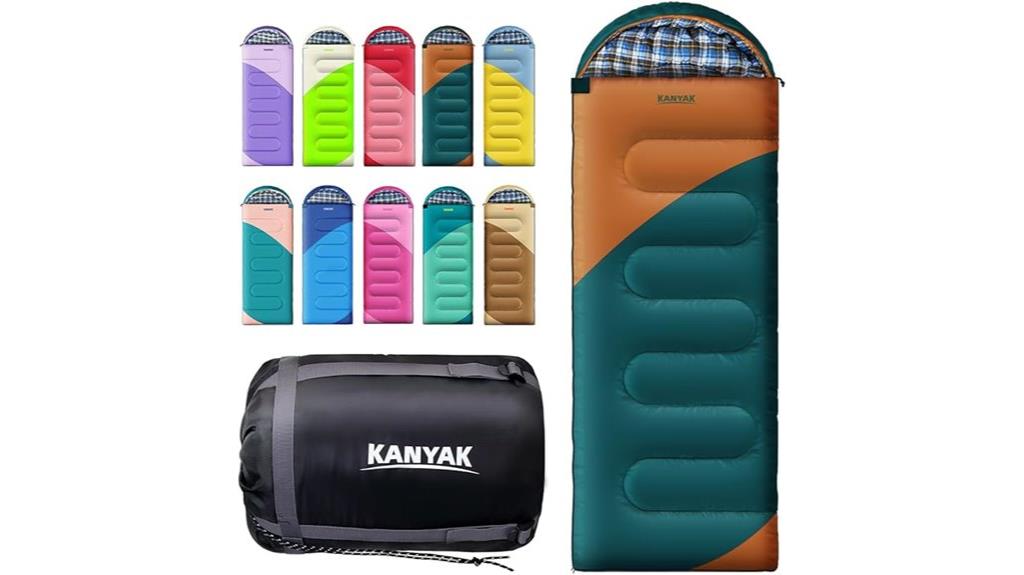
Versatility defines the Kanyak Camping Sleeping Bag, making it an excellent choice for families seeking one sleeping bag that accommodates multiple users across different seasons. You’ll find its semi-rectangular design measures 86.6″ x 32.48″, accommodating users up to 7.2 feet tall. The 210T anti-tearing polyester shell provides waterproof protection while maintaining breathability.
Three temperature ratings guide your usage: 41℉ comfort for women, 32℉ limit for men, and 23℉ extreme survival. You’ll appreciate the three-zipper system, including a separate foot zipper for ventilation control. Two bags connect to form a double sleeping bag when needed. At 4.2 pounds, it’s heavier than ultralight options but offers excellent durability for car camping and family adventures.
Best For: Families and casual campers who need a versatile, durable sleeping bag that works for multiple users across three seasons and can double as a blanket or connect with another bag.
Pros:
- Versatile design accommodates adults, kids, and teens up to 7.2 feet tall with option to connect two bags into a double
- Durable construction with 210T anti-tearing polyester shell that’s waterproof and breathable
- Three-zipper system including separate foot zipper provides excellent ventilation control and comfort
Cons:
- At 4.2 pounds, significantly heavier than ultralight backpacking options
- Some users report the temperature ratings may not be accurate for actual comfort levels
- Potential odor issues after washing according to customer feedback
KingCamp Down Sleeping Bag for Adults, 600 FP Cold Weather 3-4 Season
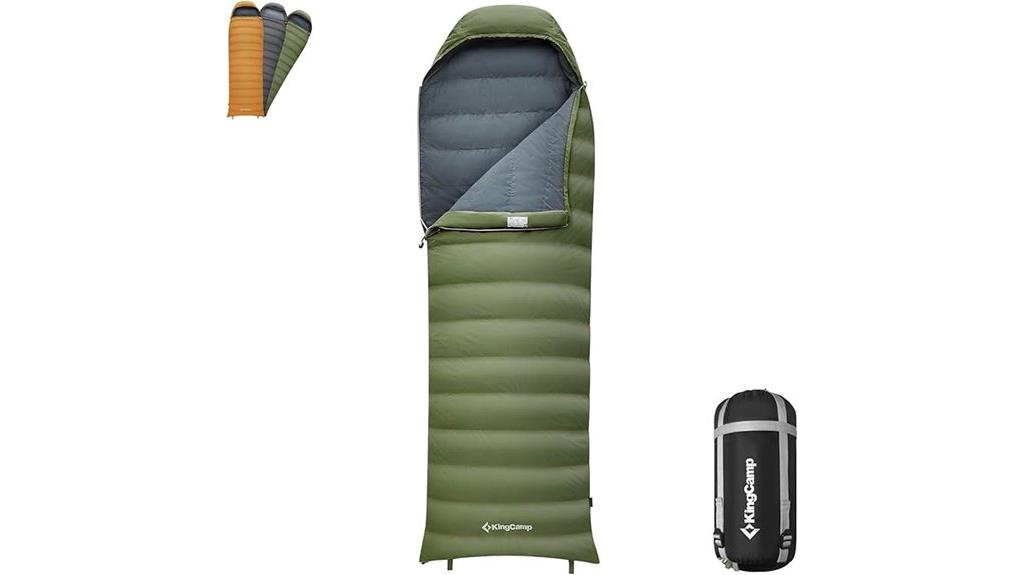
Cold weather backpackers who prioritize spacious comfort without sacrificing packability will find the KingCamp Down Sleeping Bag an excellent choice for three-season adventures. You’ll get 600 FP insulation with 1200g of premium filling that performs like 700+ FP down. The 60% white duck down and 40% eco-friendly cotton blend provides reliable warmth down to 33.8°F comfort rating.
At 86.6″ x 31.5″ and 5.5 pounds, you’ll have ample room to move while maintaining reasonable pack weight. The versatile bottom zipper lets you regulate temperature and convert the bag into a large camping mat. Durable YKK zippers and moisture-proof insulation guarantee years of dependable performance across varied conditions.
Best For: Cold weather backpackers and campers who need a spacious, versatile sleeping bag for 3-4 season use with good warmth-to-weight ratio and multi-functional capabilities.
Pros:
- Spacious dimensions (86.6″ x 31.5″) with versatile bottom zipper that converts bag into a large camping mat
- Effective insulation system with 600 FP down and 1200g filling that performs like 700+ FP down, rated for 33.8°F comfort
- Durable construction with YKK zippers, moisture-proof insulation, and eco-friendly materials blend
Cons:
- At 5.5 pounds, it’s heavier than ultralight alternatives for serious backpackers prioritizing minimal pack weight
- User reviews indicate some discrepancies between actual size/warmth performance and product specifications
- Mixed down and cotton fill (40% cotton) may not provide the same compressibility as pure down alternatives
20 Degrees F Down Sleeping Bag for Adults, 4 Season Cold Weather

Advanced cold-weather campers who demand exceptional warmth without sacrificing versatility will find the OMVMO 20 Degrees F Down Sleeping Bag delivers multi-season performance in a rectangular design. You’ll appreciate the 3D cutting technology featuring over 80 independent rectangular lofts that eliminate cold spots and maintain consistent heat distribution.
The bag’s natural white goose down fill provides reliable insulation down to 20°F, with users reporting comfortable performance at 30°F. You can configure it as a single bag, zip two together for double capacity, or wear it as a wearable cloak. The 400T 20D nylon shell includes DWR treatment for moisture resistance, while genuine YKK zippers guarantee reliable operation in harsh conditions.
Best For: Casual backpackers and car campers who want a versatile, spacious sleeping bag that can function as multiple gear pieces and perform reliably in temperatures down to 20°F.
Pros:
- Multi-functional design that works as a single bag, double bag when zipped together, wearable cloak, or blanket
- Advanced 3D cutting technology with 80+ independent lofts ensures even heat distribution and eliminates cold spots
- High-quality construction with tear-resistant nylon shell, DWR treatment, and genuine YKK zippers for durability
Cons:
- Bulkier and heavier than other down sleeping bags, making it less ideal for ultralight backpacking
- Some users report the actual warmth performance may not match the advertised 20°F rating
- Fabric requires careful handling due to sensitivity and potential for damage
Naturehike Lightweight Sleeping Bag – Compact & Ultralight for 3 Season Camping
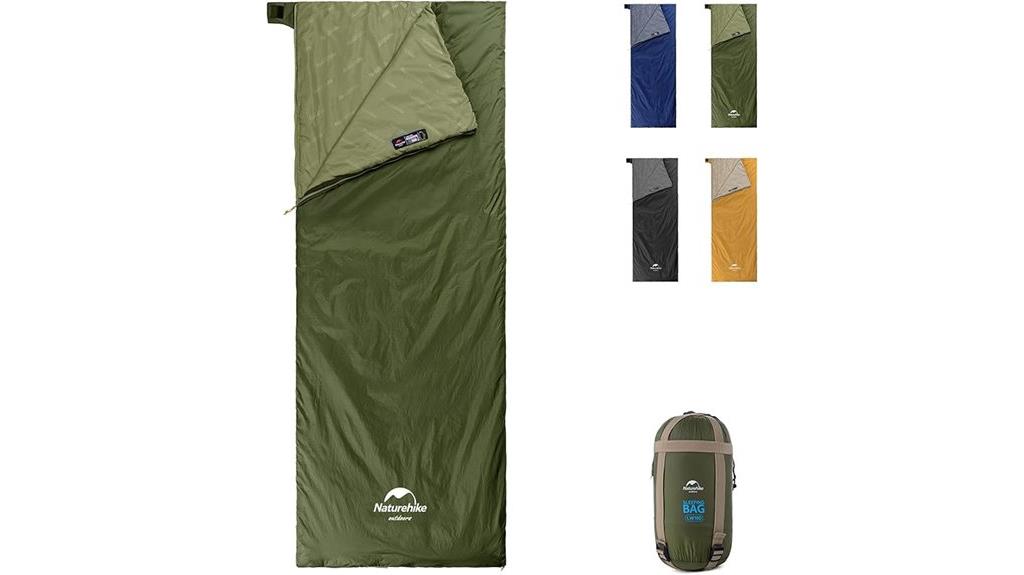
The Naturehike Lightweight Sleeping Bag delivers exceptional portability without sacrificing comfort for warm-weather backpackers who prioritize pack weight and space efficiency. You’ll appreciate its 815-gram weight and compression down to Nalgene bottle size. The bag accommodates side sleepers around 6’0″ and 175 pounds comfortably. However, you shouldn’t rely on manufacturer temperature ratings. User testing confirms effectiveness only above 60°F, with inadequate performance below 55°F. You’ll need additional insulation for temperatures approaching 40°F. The waterproof exterior and quality zipper enhance durability. This bag excels for summer three-season camping but fails in high-altitude cold environments.
Best For: Summer backpackers and warm-weather campers who prioritize ultralight gear and need a compact sleeping bag for temperatures above 60°F.
Pros:
- Exceptional portability at 815 grams with compression to Nalgene bottle size
- Comfortable for side sleepers around 6’0″ with good roominess and loft
- Quality waterproof exterior and zipper with excellent price-to-quality ratio
Cons:
- Inadequate insulation below 55-60°F despite manufacturer temperature ratings
- Requires additional layers for comfort in temperatures approaching 40°F
- Unsuitable for high-altitude or cold-weather camping conditions
Factors to Consider When Choosing a Rectangular Sleeping Bag for Backpacking
When I’m selecting a rectangular sleeping bag for backpacking, I evaluate five critical factors that directly impact performance and comfort on the trail. Weight and packability determine how much space the bag consumes in your pack, while temperature rating accuracy guarantees you’ll stay warm at your destination’s lowest expected temperatures. I also examine material durability, precise size dimensions, and insulation type performance to match the bag’s capabilities with my specific backpacking requirements.
Weight and Packability
Everything about your backpacking experience hinges on carrying the right gear weight, and your rectangular sleeping bag‘s mass directly impacts your trail performance. I recommend targeting bags under 4 lbs for long-distance hiking. The weight range spans dramatically from 1.58 lbs for ultralight models to over 9 lbs for heavy-duty options.
Packability matters equally. You’ll want compression sacks that reduce your bag to 15 x 9.4 inches or smaller. This compact dimension fits efficiently in most backpacks without dominating space.
Down-filled bags typically offer superior compression ratios compared to synthetic materials. They’ll pack tighter while maintaining warmth-to-weight efficiency. Ultralight options excel here, delivering both temperature regulation and minimal bulk. Every ounce counts on extended trails, making weight and packability your primary selection criteria.
Temperature Rating Accuracy
Temperature ratings serve as your primary guide for selecting a rectangular sleeping bag, yet these numbers often mislead backpackers into dangerous situations. I’ve found significant variations between brands using identical temperature ratings. A bag rated for 32°F comfort might leave you shivering if you’re a cold sleeper.
Most manufacturers provide three ratings: comfort, limit, and extreme. The comfort rating indicates temperatures where you’ll sleep warmly. The limit rating represents survival temperatures for average users. Extreme ratings shouldn’t guide your purchasing decisions.
Customer reviews consistently reveal discrepancies between advertised ratings and real-world performance, especially in extreme conditions. I recommend adding a 10-15°F buffer to manufacturer ratings. Always plan for additional insulation layers and quality sleeping pads to compensate for potential rating inaccuracies.
Material and Durability
Although temperature ratings grab most attention during bag selection, the materials and construction quality determine whether your rectangular sleeping bag survives multiple backpacking seasons. I prioritize outer shells made from ripstop nylon or polyester with DWR coating for water resistance. These materials typically offer 20-40 denier fabric weight, balancing durability against packability.
Inner linings should feature soft polyester pongee or cotton flannel against your skin. I examine stitching quality closely—look for reinforced seams and bartacked stress points. YKK zippers outperform generic alternatives substantially. Down insulation provides superior warmth-to-weight ratios but requires dry conditions. Synthetic fills like PrimaLoft maintain insulation when wet, though they’re bulkier.
Proper maintenance extends material life considerably. I wash sleeping bags in front-loading machines using specialized cleaners, then store them uncompressed in breathable storage sacks.
Size and Dimensions
While material quality determines longevity, proper sizing makes the difference between restful sleep and a cramped night outdoors. Standard rectangular bags measure 86 inches long by 33-39 inches wide, accommodating campers up to 6’4″ comfortably. This extra width allows natural movement during sleep, unlike restrictive mummy designs.
I recommend considering semi-rectangular options for balanced space and thermal efficiency. These hybrid designs retain roominess while reducing cold spots that plague oversized bags.
Packed dimensions matter considerably for backpacking. Quality rectangular bags compress to approximately 15 x 10 inches when stuffed properly. Weight ranges from 3-4 pounds for lightweight models to 9+ pounds for heavily insulated versions. Choose based on your pack’s capacity and hiking distance. Heavier bags suit car camping better than multi-day treks.
Insulation Type Comparison
Choosing between down and synthetic insulation fundamentally shapes your backpacking experience through weight, performance, and reliability trade-offs. Down delivers superior warmth-to-weight ratios and compresses smaller in your pack. You’ll achieve lower temperature ratings at reduced weight compared to synthetic alternatives. However, down loses insulation when wet unless treated with water-resistant coatings, and it’s more expensive.
Synthetic polyester fibers insulate effectively when damp and dry faster than down. They’re more affordable and resilient to rough camping conditions. The trade-off is increased bulk and weight in your pack.
Down requires careful handling to prevent punctures that compromise insulation. Synthetic materials withstand wear better but compress less over time. Consider your climate, budget, and handling preferences when selecting insulation type.
Zipper Quality Features
Your sleeping bag’s zipper determines whether you’ll enjoy convenient access or wrestle with frustrating snags during cold morning exits. I recommend prioritizing anti-snag zippers that feature smooth-gliding coil construction, preventing fabric catches that plague cheaper alternatives.
Two-way zipper systems offer superior functionality. You can unzip from the bottom for ventilation or quick foot access while maintaining upper body warmth. This dual-operation design proves invaluable during temperature fluctuations.
Draft tubes create essential thermal barriers along zipper lines. These insulated strips seal gaps that otherwise allow heat loss, maintaining your bag’s temperature rating effectiveness.
Oversized zipper pulls guarantee reliable operation with gloved hands. Standard pulls become nearly impossible to grip in cold conditions.
Reinforced zipper construction withstands repeated field use. Look for YKK zippers with reinforced stress points and heavy-duty tape backing for long-term durability.
Water Resistance Properties
When moisture penetrates your sleeping bag’s shell fabric, it compromises insulation performance and creates uncomfortable sleeping conditions that can ruin backcountry trips. I evaluate water resistance through material specifications and construction methods. Look for sleeping bags with 40D tear-resistant polyester or waterproof nylon shells that provide superior moisture protection. Higher denier counts indicate better durability and water penetration resistance.
DWR (Durable Water Repellent) coatings add essential protection against rain and dew. I recommend checking hydrostatic head ratings, which measure water pressure resistance before seepage occurs. A rating of 1,500mm provides adequate protection for light precipitation, while 3,000mm handles heavy rain.
Breathable design prevents internal condensation buildup without sacrificing water resistance. This balance guarantees you’ll stay dry from external moisture while avoiding trapped humidity inside your sleeping bag.
Compression Sack Efficiency
Although rectangular sleeping bags typically pack larger than mummy designs, compression sacks drastically reduce their volume for efficient backpacking transport. I’ve found that quality compression sacks can compress rectangular bags to water bottle-sized packages, making them surprisingly packable for trail use.
The key is selecting compression sacks with even pressure distribution. This protects your bag’s insulation from damage while maintaining thermal efficiency over time. Look for sacks with sturdy materials and reliable closures—they’ll shield your sleeping bag from moisture and trail debris.
Weight matters too. Most compression sacks add only minimal ounces to your pack weight, which is critical when you’re counting every gram. I recommend choosing compression sacks with strong zippers and durable fabric that withstand repeated compression cycles without compromising your sleeping bag’s performance.
Frequently Asked Questions
Can Rectangular Sleeping Bags Be Used in Ultralight Backpacking Setups?
I’d say rectangular sleeping bags can work for ultralight backpacking, but they’re typically heavier and bulkier than mummy bags. You’ll need to find ultralight models and accept some weight trade-offs for comfort.
How Do I Properly Clean and Maintain My Rectangular Sleeping Bag?
I’ll wash your rectangular sleeping bag in a front-loading machine with gentle detergent, then air dry it completely. I recommend spot-cleaning stains immediately and storing it uncompressed in a breathable storage sack.
What’s the Difference Between Temperature Rating and Comfort Rating?
I’ll explain the key difference: temperature rating indicates the lowest temperature where you’ll survive, while comfort rating shows the temperature where you’ll actually sleep comfortably without feeling cold.
Are Rectangular Sleeping Bags Suitable for Side Sleepers and Restless Sleepers?
I’d say rectangular sleeping bags are excellent for side sleepers and restless sleepers. You’ll get more room to move around, shift positions, and sleep naturally without feeling constricted like you would in mummy bags.
How Long Do Rectangular Sleeping Bags Typically Last With Regular Use?
I’ve found that rectangular sleeping bags typically last 5-10 years with regular use. Higher-quality bags with durable fabrics and reinforced stitching can extend beyond that, while budget options might show wear after 3-5 years.
On a final note
I’ve analyzed eight top rectangular sleeping bags covering temperature ranges from -25°F to 45°F. Each model offers distinct advantages for different backpacking conditions. Your choice depends on three critical factors: expected temperatures, pack weight limits, and comfort preferences. Consider the Coleman Dunnock for moderate cold, TETON Celsius XL for extreme conditions, or Naturehike for ultralight needs. Match the bag’s temperature rating to your lowest expected overnight temperature for peak performance.

